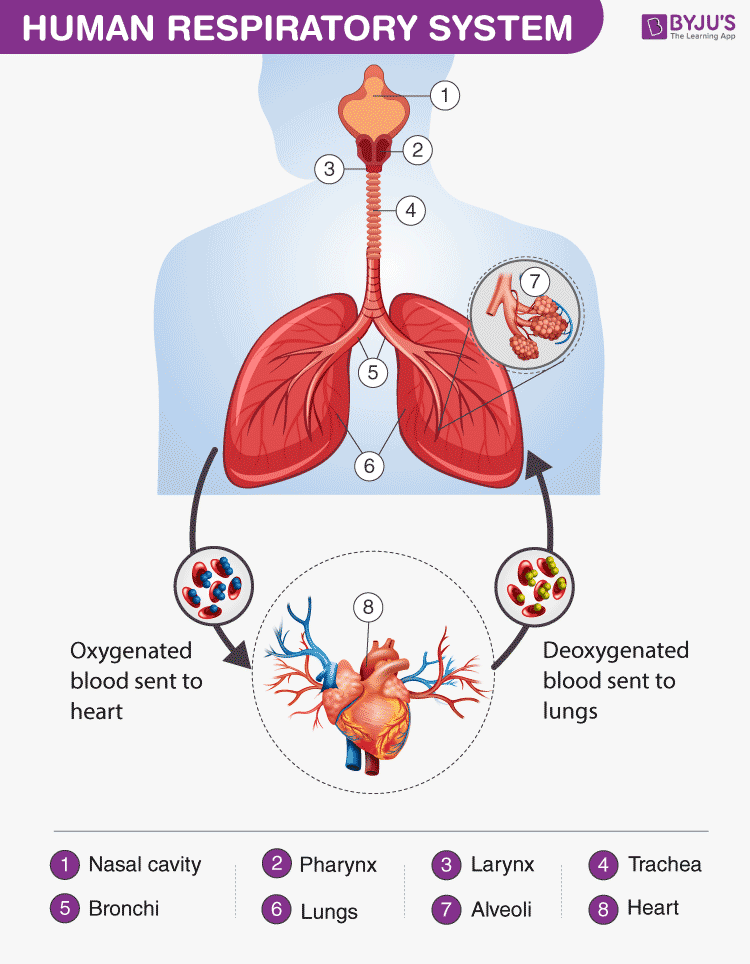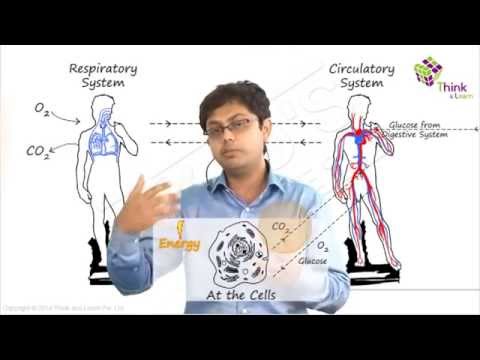Respiratory system of Humans
Breathing involves gaseous exchange through inhalation and exhalation. The human respiratory system has the following main structures – Nose, mouth, pharynx, larynx, trachea, bronchi, and lungs. Explore in detail.
Table of Contents
Respiratory System Definition
“Human Respiratory System is a network of organs and tissues that helps us breathe. The primary function of this system is to introduce oxygen into the body and expel carbon dioxide from the body.”
What is the Respiratory System?
As defined above, the human respiratory system consists of a group of organs and tissues that help us to breathe. Aside from the lungs, there are also muscles and a vast network of blood vessels that facilitate the process of respiration.
Also Read: Mechanism of Breathing
Human Respiratory System Diagram
To gain a clearer understanding, we have illustrated the human respiratory system and its different parts involved in the process.

Human Respiratory System Diagram showing different parts of the Respiratory Tract
Features of the Human Respiratory System
The respiratory system in humans has the following important features:
- The energy is generated by the breakdown of glucose molecules in all living cells of the human body.
- Oxygen is inhaled and is transported to various parts and are used in the process of burning food particles (breaking down glucose molecules) at the cellular level in a series of chemical reactions.
- The obtained glucose molecules are used for discharging energy in the form of ATP- (adenosine triphosphate)
Also Read: Difference between trachea and oesophagus

Respiratory System Parts and Functions
Let us have a detailed look at the different parts of the respiratory system and their functions.
Nose
Humans have exterior nostrils, which are divided by a framework of cartilaginous structure called the septum. This is the structure that separates the right nostril from the left nostril. Tiny hair follicles that cover the interior lining of nostrils act as the body’s first line of defence against foreign pathogens. Furthermore, they provide additional humidity for inhaled air.
Larynx
Two cartilaginous chords lay the framework for the larynx. It is found in front of the neck and is responsible for vocals as well as aiding respiration. Hence, it is also informally called the voice box. When food is swallowed, a flap called the epiglottis folds over the top of the windpipe and prevents food from entering into the larynx.
Also check: What is the role of epiglottis and diaphragm in respiration?
Pharynx
The nasal chambers open up into a wide hollow space called the pharynx. It is a common passage for air as well as food. It functions by preventing the entry of food particles into the windpipe. The epiglottis is an elastic cartilage, which serves as a switch between the larynx and the oesophagus by allowing the passage of air into the lungs, and food in the gastrointestinal tract.
Have you ever wondered why we cough when we eat or swallow?
Talking while we eat or swallow may sometimes result in incessant coughing. The reason behind this reaction is the epiglottis. It is forced to open for the air to exit outwards and the food to enter into the windpipe, triggering a cough.
Trachea
The trachea or the windpipe rises below the larynx and moves down to the neck. The walls of the trachea comprise C-shaped cartilaginous rings which give hardness to the trachea and maintain it by completely expanding. The trachea extends further down into the breastbone and splits into two bronchi, one for each lung.
Bronchi
The trachea splits into two tubes called the bronchi, which enter each lung individually. The bronchi divide into secondary and tertiary bronchioles, and it further branches out into small air-sacs called the alveoli. The alveoli are single-celled sacs of air with thin walls. It facilitates the exchange of oxygen and carbon dioxide molecules into or away from the bloodstream.
Lungs
Lungs are the primary organs of respiration in humans and other vertebrates. They are located on either side of the heart, in the thoracic cavity of the chest. Anatomically, the lungs are spongy organs with an estimates total surface area between 50 to 75 sq meters. The primary function of the lungs is to facilitate the exchange of gases between the blood and the air. Interestingly, the right lung is quite bigger and heavier than the left lung.
Also Read: Respiration
Respiratory Tract
The respiratory tract in humans is made up of the following parts:
- External nostrils – For the intake of air.
- Nasal chamber – which is lined with hair and mucus to filter the air from dust and dirt.
- Pharynx – It is a passage behind the nasal chamber and serves as the common passageway for both air and food.
- Larynx – Known as the soundbox as it houses the vocal chords, which are paramount in the generation of sound.
- Epiglottis – It is a flap-like structure that covers the glottis and prevents the entry of food into the windpipe.
- Trachea – It is a long tube passing through the mid-thoracic cavity.
- Bronchi – The trachea divides into left and right bronchi.
- Bronchioles – Each bronchus is further divided into finer channels known as bronchioles.
- Alveoli – The bronchioles terminate in balloon-like structures known as the alveoli.
- Lungs – Humans have a pair of lungs, which are sac-like structures and covered by a double-layered membrane known as pleura.
Air is inhaled with the help of nostrils, and in the nasal cavity, the air is cleansed by the fine hair follicles present within them. The cavity also has a group of blood vessels that warm the air. This air then passes to the pharynx, then to the larynx and into the trachea.
The trachea and the bronchi are coated with ciliated epithelial cells and goblet cells (secretory cells) which discharge mucus to moisten the air as it passes through the respiratory tract. It also traps the fine bits of dust or pathogen that escaped the hair in the nasal openings. The motile cilia beat in an ascending motion, such that the mucus and other foreign particles are carried back to the buccal cavity where it may either be coughed out (or swallowed.)
Once the air reaches the bronchus, it moves into the bronchioles, and then into the alveoli.
Respiratory System Functions
The functions of the human respiratory system are as follows:
Inhalation and Exhalation
The respiratory system helps in breathing (also known as pulmonary ventilation.) The air inhaled through the nose moves through the pharynx, larynx, trachea and into the lungs. The air is exhaled back through the same pathway. Changes in the volume and pressure in the lungs aid in pulmonary ventilation.
Exchange of Gases between Lungs and Bloodstream
Inside the lungs, the oxygen and carbon dioxide enter and exit respectively through millions of microscopic sacs called alveoli. The inhaled oxygen diffuses into the pulmonary capillaries, binds to haemoglobin and is pumped through the bloodstream. The carbon dioxide from the blood diffuses into the alveoli and is expelled through exhalation.
Also read: Exchange Of Gases in Plants
Exchange of Gases between Bloodstream and Body Tissues
The blood carries the oxygen from the lungs around the body and releases the oxygen when it reaches the capillaries. The oxygen is diffused through the capillary walls into the body tissues. The carbon dioxide also diffuses into the blood and is carried back to the lungs for release.
The Vibration of the Vocal Cords
While speaking, the muscles in the larynx move the arytenoid cartilage. These cartilages push the vocal cords together. During exhalation, when the air passes through the vocal cords, it makes them vibrate and creates sound.
Olfaction or Smelling
During inhalation, when the air enters the nasal cavities, some chemicals present in the air bind to it and activate the receptors of the nervous system on the cilia. The signals are sent to the olfactory bulbs via the brain.
Also Read: Respiratory System Disorders
Respiration is one of the metabolic processes which plays an essential role in all living organisms. However, lower organisms like the unicellular do not “breathe” like humans – intead, they utilise the process of diffusion. Annelids like earthworms have a moist cuticle which helps them in gaseous exchange. Respiration in fish occurs through special organs called gills. Most of the higher organisms possess a pair of lungs for breathing.
Also Read: Amphibolic Pathway
To learn more about respiration, check out the video below:

Frequently Asked Questions
What is the human respiratory system?
The human respiratory system is a system of organs responsible for inhaling oxygen and exhaling carbon dioxide in humans. The important respiratory organs in living beings include- lungs, gills, trachea, and skin.
What are the important respiratory system parts in humans?
The important human respiratory system parts include- Nose, larynx, pharynx, trachea, bronchi and lungs.
What is the respiratory tract made up of?
The respiratory tract is made up of nostrils, nasal chamber, larynx, pharynx, epiglottis, trachea, bronchioles, bronchi, alveoli, and lungs.
What are the main functions of the respiratory system?
The important functions of the respiratory system include- inhalation and exhalation of gases, exchange of gases between bloodstream and lungs, the gaseous exchange between bloodstream and body tissues, olfaction and vibration of vocal cords.
What are the different types of respiration in humans?
The different types of respiration in humans include- internal respiration, external respiration and cellular respiration. Internal respiration includes the exchange of gases between blood and cells, external respiration is the breathing process, whereas cellular respiration is the metabolic reactions taking place in the cells to produce energy.
What are the different stages of aerobic respiration?
Aerobic respiration is the process of breaking down glucose to produce energy. It occurs in the following different stages- glycolysis, pyruvate oxidation, citric acid cycle or Krebs cycle, and electron transport system.
Why do the cells need oxygen?
Our body cells require oxygen to release energy. The oxygen inhaled during respiration is used to break down the food to release energy.
What is the main difference between breathing and respiration in humans?
Breathing is the physical process of inhaling oxygen and exhaling carbon dioxide in and out of our lungs. On the contrary, respiration is the chemical process where oxygen is utilized to break down glucose to generate energy to carry out different cellular processes.
Explore more details about the human respiratory system or other related topics by registering at BYJU’S Biology

Wow!!!!! Great notes . Thankyou byjus
Wow! this is really helpful. Thank you
Greet notes
Very helpful
Very nice information
good answers!
Superb
Thank you so much for the notes
Great notes helpful for students
The notes are really amazing. It helped me a lot. Thank you BYJU’S
The notes are amazing. It helped me a lot. Thank you Byju’s.
Thank you for the notes helpful in the revision
Very good notes. I love Byjus learning application
thank you byjus
These notes are very good for study, thank u so much Byjus.
Helpful for studying. Informative about the topic. Great notes!
Great job you are great Byjus and your notes is superb ❤❤❤❤❣❣❣❣❣🙏🙏🙏🙏